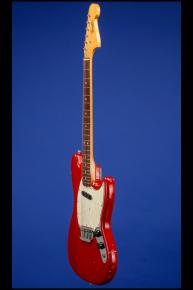First Year Musicmaster II.
1965 Fender Musicmaster II.
This 12-inch wide, one and a half inch thick guitar weighs just 6.70 lbs. and has a narrow 'A' nut width of 1 1/2 inches and a scale length of 24 inches. Solid alder 'slab' body, maple neck, and veneer rosewood fretboard with 22 original thin frets and pearl dot position markers. Fender 'Transitional' logo with "Fender" in gold with black trim, beneath that "Musicmaster ll" and beneath that "Pat. 2,573,254 3,143,028". Single "butterfly" string tree. Individual 'double-line' Kluson Deluxe tuners with white plastic oval buttons (each one stamped on the underside "D-169400 / Patent No.". Four-bolt neck plate with serial number "L78705" between the top two screws. The neck is stamped in black "8 APR 65A". One black bakelite, gray bottom single-coil Musicmaster pickup, angled at neck, with an output of 5.17k ("5-26-65" written in black pencil on the underside). Two controls (one volume, one tone) and jack socket, all on the three-layer pearloid over black and white plastic pickguard with twelve screws. Black plastic control knobs with seven sides and white line marker. Combined bridge/tailpiece with three adjustable 'threaded' saddles. The neck is stamped "8 APR 65A." The potentiometers are stamped "304 6512" (Stackpole, March 1965). The Dakota Red color is fresh and shows no signs of darkening. There are a few small surface chips mainly on the edges of the body. Overall this all original little guitar is in excellent-plus (8.75) condition. Housed in a later three-latch rectangular black hardshell case with gray plush lining (9.00).
"Fender's new 'student' guitars, the Duo-Sonic and Musicmaster, first appeared in 1956. They had smaller, lighter bodies, shorter necks and basic appointments. The Musicmaster was the single-pickup version...Despite their budget status, the student models were still playable instruments: Fender seemed to have cut the right corners" (Tony Bacon and Paul Day, The Fender Book, p. 29). Although Fender used the term "three-quarter size" in publicizing the new student models, only the neck and the resulting scale-length were smaller, designed for younger hands that were just starting to play guitar.











